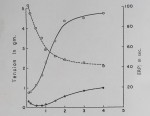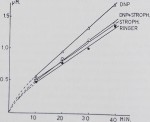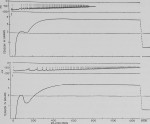Warning: Trying to access array offset on value of type null in /home/elisew5/public_html/drpeterwitt.com/wp-content/plugins/contextual-related-posts/includes/content.php on line 49
View this article in Search Friendly Plain Text
NOTE: This plain text article interpretation has been digitally created by OCR software to estimate the article text, to help both users and search engines find relevant article content. To read the actual article text, view or download the PDF above.
Reprint of an abstract of a communication presented at the
1st international pharmacological
MEETING STOCKHOLM, SWEDEN August 22-25, 1961
CALCIUM AND DIGITALIS ACTION ON HEART MUSCLE
By A. E. FARAH and P. N. WITT (U.S.A.)
Reprinted from “Biochemical PharmacologyVol. 8, No. 1, August, ig6i
PERGAMON PRESS
OXFORD • LONDON • NEW YORK • PARIS

275 Calcium and Digitalis Action on Heart
Muscle. A. E. Farah and P. N. Witt (U.S.A.).
Changes in extracellular Ca concentration affect contractility of cardiac muscle. Ca acts on the excitable membrane, on the excitation-contraction coupling mechanism, and on contractile proteins. Digitalis effects are influenced by changes in Ca concentration. Thus an increase in Ca in the medium increases the toxicity of digitalis glycosides. The effects of digitalis on cardiac contractility are also related to Ca concentration, however, here the data indicate an additive effect of Ca and digitalis.
Ca content of the heart is not measurably changed by therapeutic doses of digitalis glycosides. Uptake of 45Ca by the beating heart muscle is not changed by 10-7 M ouabain, while 10-6 M ouabain significantly increases uptake. The latter is a highly toxic concentration which causes contracture. Indirect evidence indicates that 45Ca efflux is not significantly changed by therapeutic amounts of ouabain. Furthermore, there are distinct differences between Ca and digitalis actions on the heart. It is unlikely that digitalis in therapeutic doses acts through either increasing the rate of uptake or decreasing the rate of loss or changing the total amount of Ca in heart muscle. This does not exclude the possibility that intracellular redistribution of Ca may be operative, but this has not been studied.
Ouabain produces an increase in the rate-dependent inotropic effects of heart muscle. When the increase in contractility at high rates is depressed, ouabain in low concentrations (10~8 to 5 X IO8 M) restores these phenomena. High or toxic concentrations of ouabain depress or eliminate the rate-dependent positive inotropic effects. It is proposed that therapeutic doses of digitalis act on the mechanism that causes the rate-dependent changes in contractility. Our results show that positive inotropic effects due to ouabain as well as Ca are not related to the changes in intracellular ionic composition as proposed by Hajdu.(l)
(Supported by a grant from the American Heart Association.)
1. Hajdu and Leonard (1959), Pharmac. Rev.
Biochemical Pharmacology
AIMS
This international journal will be devoted to research into the development of biologically active substances and their mode of action at the biochemical and sub-cellular level.
Full length papers will be published approximately four months, and short communications in six to eight weeks, after final acceptance.
In addition to original research papers, the journal will offer immediate publication for Short Communications. Letters to the Editors, offering comment on previous articles, will also be accepted, when the contribution is considered warranted by the Editors.
The journal will include reports on all types of cells (plant, micro-organism and animal), but particular emphasis will be given to cancer chemotherapy and related studies. It is hoped that research will be stimulated as a result of collecting together in one publication investigations from different fields having as a common link the same fundamental problems.
The new journal will provide a forum for the publication of all phases of pure and applied cellular pharmacology including organochemical, physicochemical, biochemical and cytological studies. By including all aspects of research involved in the development of biologically active materials (chemotherapeutic agents as well as insecticides, fungicides, plant growth regulators, etc.), it is hoped that a better appreciation of the problems involved will be attained. In the past the different research approaches which make up these investigations have almost invariably been reported in a number of widespread publications and the interplay of different types of investigations towards solving the main problem has thereby been available only with difficulty to workers in neighbouring fields. Biochemical Pharmacology is intended to remedy this defect and to provide a means of viewing the entire field in its proper perspective.


